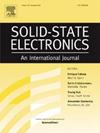Interface roughness in Resonant Tunnelling Diodes for physically unclonable functions
IF 1.4
4区 物理与天体物理
Q3 ENGINEERING, ELECTRICAL & ELECTRONIC
引用次数: 0
Abstract
Resonant Tunnelling Diodes with Interface Roughness (IR) were investigated for their potential as components of Physically Uncloneable Functions (PUFs). A comparison of an RTD with IR, against a ‘smooth’ device without IR, showed a reduction in current and Peak to Valley Current Ratio (PVCR) between the resonant peak and valley currents . Furthermore, IR resulted in a perturbation of the Negative Differential Region (NDR) of the IV characteristic to higher bias. This perturbation was due to IR effectively thickening barriers and thereby narrowing the Quantum Well (QW) and leading to a higher ground state QW energy. Variation of correlation length and roughness asperity for batches of 25 randomly generated RTDs with IR showed that increasing decreased mean PVCR and increased the standard deviation of the resonant peak voltage and current . 150 RTDs with an of 7.5 nm and of 0.3 nm resulted in a min-entropy of 1.275 bits, showing that 100 RTDs could idealistically compose a PUF encoding 127 bits.
物理不可克隆功能的共振隧道二极管的界面粗糙度
研究了具有界面粗糙度(IR)的共振隧道二极管作为物理不可克隆功能(puf)元件的潜力。带IR的RTD与不带IR的“光滑”器件的比较显示,谐振峰值和谷电流IR /Iv之间的电流和峰谷电流比(PVCR)降低。此外,红外导致IV特征的负微分区(NDR)扰动到更高的偏置。这种扰动是由于红外有效地增厚了势垒,从而缩小了量子阱(QW),导致了更高的基态QW能量。随机生成的25个rtd的相关长度LC和粗糙度ΔRMS随IR的变化表明,增加ΔRMS降低了平均PVCR,增加了谐振峰值电压Vr和电流IR的标准差。150个LC为7.5 nm和ΔRMS为0.3 nm的rtd的最小熵为1.275比特,表明100个rtd可以理想地组成编码127比特的PUF。
本文章由计算机程序翻译,如有差异,请以英文原文为准。
求助全文
约1分钟内获得全文
求助全文
来源期刊

Solid-state Electronics
物理-工程:电子与电气
CiteScore
3.00
自引率
5.90%
发文量
212
审稿时长
3 months
期刊介绍:
It is the aim of this journal to bring together in one publication outstanding papers reporting new and original work in the following areas: (1) applications of solid-state physics and technology to electronics and optoelectronics, including theory and device design; (2) optical, electrical, morphological characterization techniques and parameter extraction of devices; (3) fabrication of semiconductor devices, and also device-related materials growth, measurement and evaluation; (4) the physics and modeling of submicron and nanoscale microelectronic and optoelectronic devices, including processing, measurement, and performance evaluation; (5) applications of numerical methods to the modeling and simulation of solid-state devices and processes; and (6) nanoscale electronic and optoelectronic devices, photovoltaics, sensors, and MEMS based on semiconductor and alternative electronic materials; (7) synthesis and electrooptical properties of materials for novel devices.
 求助内容:
求助内容: 应助结果提醒方式:
应助结果提醒方式:


